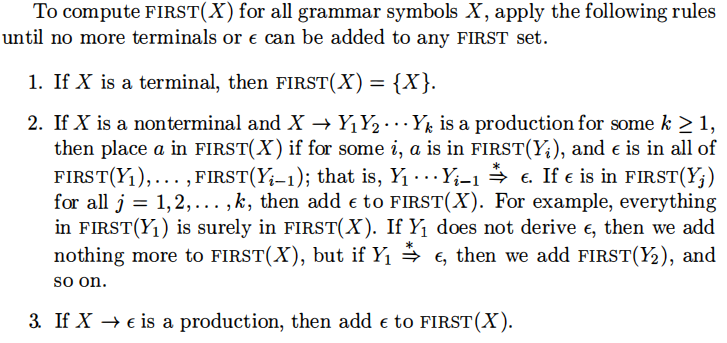[编译原理]2.语法分析(syntax analysis)
There are three general types of parsers for grammars
| universal | top-down | bottom-up |
|---|---|---|
| Cocke-Younger-Kasami algorithm, Earley's algorithm | ||
| parse any grammar, inefficient | work only for subclasses of grammars | work only for subclasses of grammars |
strategies for error recovery:panic-mode,phrase-level recovery,error-productions,global-correction
a compiler is expected to assist the programmer in locating and tracking down errors
error handler in a parser has goals:
- Report the presence of errors clearly and accurately.
- Recover from each error quickly enough to detect subsequent errors.
- Add minimal overhead to the processing of correct programs.
一、context-free grammar
由一系列production组成
- terminal symbols
- nonterminals
- productions
- start symbol
Derivation: sentential form, sentence, left-sentential form, leftmost derivation, rightmost derivation
Every construct that can be described by a regular expression can be described by a grammar, but not vice-versa.
Immediate left recursion can be eliminated by the following technique


Algorithm 4.19, below, systematically eliminates left recursion from a grammar.

二、top-down parsing
top-down parsing method 有3种: recursive-descent parsing, predictive parsing 和 nonrecursive predictive parsing,
predictive parsing 是一种特殊的 recursive-descent parsing。
有一类 predictive parsing 一定能够解析的 grammar 称为 LL(1) grammar, left-recursive grammar 和 ambiguous grammar 一定不是 LL(1) grammar。
当且仅当一个 grammar \(G\) 满足下列条件时,\(G\) 才能成为一个 LL(1) grammar:
若 \(A \to \alpha | \beta\) 是两个不同的 productions, 则
1)\(FIRST(\alpha) \cap FIRST(\beta) = \emptyset\)
2)若 \(\epsilon \in FIRST(\beta)\), 则 \(FIRST(\alpha) \cap FOLLOW(\beta) = \emptyset\); \(\epsilon \in FIRST(\alpha)\) 同理。
为predictive parsing method 构造 parsing table 的算法:
输入为 grammar \(G\),
输出为 parsing table \(M\)。
对 grammar \(G\) 中的所有 production \(A \to \alpha\) 执行以下两步操作:
- \(\forall a \in FIRST(\alpha)\), 将\(A \to \alpha\)添加到 \(M[A,a]\) 中
- 若\(\epsilon \in FIRST(\alpha)\), 则 \(\forall b \in FOLLOW(\alpha)\), 将 \(A \to \alpha\)添加到 \(M[A,b]\) 中
若 \(\exists A, a, s.t. M[A, a] = \emptyset\) , 则令\(M[A, a] =\) error
注意,对于 LL(1) grammar, table \(M\) 中的每一个 entry 至多包含一条 production。
考虑\(A \to \alpha | \beta\),我们来说明它们不可能出现在同一个 entry 中。
LL(1) grammar 的条件 1 说明,这两条 production 经过步骤 1 ,不可能出现在同一个 entry 中
LL(1) grammar 的条件 1 说明\(FIRST(\alpha), FIRST(\beta)\) 不可能同时包含 \(\epsilon\), 所以两条 production 至多只有一条能经过步骤 2 添加到 \(M\) 中,
而LL(1) grammar 的条件 2 又说明,经过步骤 2 添加到 \(M\) 中的那条 production 与另外一条 production 不可能出现在同一个 entry 中。
计算FIRST的方法

计算FOLLOW的方法


三、bottum-up parsing
下面介绍 3 种 bottum-up 方法,SLR, canonical LR (LR for short) 和 LALR, 它们都基于 shift-reduce 方法
我们先看一下 3 种 LR 型 parser 的共同点,然后再看它们之间的差异
1.LR 型 parser 的构造过程
\(item \to DFA \to parsing\) \(table\)
\(DFA\) 的一个 \(state\) 对应一个由若干 \(item\) 构成的一个 \(set\)
2.LR型 parser 的结构和工作原理

LR 型的 parser 结构如上图所示,有一个存储 state 的栈, 一块存储输入的缓冲区, 还有一张用来做决策的 parsing table。
1)parser 每次都根据栈顶的 state 和缓冲区中下一个输入的 terminal 去查询 parsing table 的 action 区域,决定接下来是 shift, reduce, accept 还是 error。
2)如果是 reduce, 则要弹出栈顶代表 handle 的若干 state, 再根据新的栈顶 state 和用来代替 handle 的 nonterminal 去查询 parsing table 的 goto 区域,并将跳转的下一个 state 压入栈顶或者是 error。
ps:从任意其它 state 进入 state j 一定是通过相同的 grammar symbol X。
pss:所有的 LR 型 grammar 都是 unambiguous 的。
3.SLR, LR 和 LALR 的区别
三种 paser 使用了不同的 item,
| item | parser | grammar | state size |
|---|---|---|---|
| LR(0) | SLR | SLR | small |
| LR(1) | LR | LR | large |
| LALR(1) | LALR | LALR | small |
An \(LR(0)\) \(item\) of a grammar \(G\) is a production of G with a dot at some position of the body. Thus, production \(A \to XYZ\) yields the four items
\(A \to ·XYZ\)
\(A \to X·YZ\)
\(A \to XY·Z\)
\(A \to XYZ·\)
An \(LR(1)\) \(item\) has the form \([A \to \alpha·\beta, a]\) , where \(A \to \alpha\beta\) is a production and \(a\) is a terminal or the right endmarker \(\$\).
Recall that in the SLR method, state $i$ calls for reduction by $A \to \alpha$ if the set of items $I_i$ contains item $[A \to \alpha·]$ and $a$ is in FOLLOW($A$). In some situations, however, when state $i$ appears on top of the stack, the viable prefix $\beta\alpha$ on the stack is such that $\beta A$ cannot be followed by $a$ in any right-sentential form.
maybe Follow(\(A\)) != Follow(\(\beta A\))
Sets of LR(1) items 构造方法

